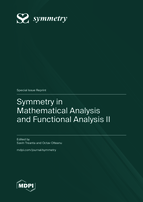Symmetry in Mathematical Analysis and Functional Analysis II
A special issue of Symmetry (ISSN 2073-8994). This special issue belongs to the section "Mathematics".
Deadline for manuscript submissions: closed (30 September 2023) | Viewed by 10419
Special Issue Editors
Interests: variational and functional analysis; optimization methods; control theory; differential equations
Special Issues, Collections and Topics in MDPI journals
Interests: Hahn-Banach type theorems; Markov moment problem; polynomial approximation on unbounded subsets; operatorial equations; inequalities
Special Issues, Collections and Topics in MDPI journals
Special Issue Information
Dear Colleagues,
As we all know, the role and consequences of the notion of symmetry in mathematics and related sciences are very important. In this Special Issue, we want to establish some theoretical results (and their applications) in the fields of mathematical analysis and functional analysis, in which the concept of symmetry plays an essential role. More specifically, we aim to investigate various problems in areas such as optimization problems, polynomial approximation on unbounded subsets, moment problems, variational inequalities, evolutionary problems, dynamical systems, generalized convexity, partial differential equations, and special spaces of self-adjoint operators. Some of these areas of research are strongly intercorrelated. Therefore, I cordially invite you to publish your results (articles or review-papers) on related subjects in this Special Issue.
Submit your paper and select the Journal Symmetry and the Special Issue “Symmetry in Mathematical Analysis and Functional Analysis Ⅱ” via the MDPI submission system. Our papers will be published on a rolling basis, and we will be pleased to receive your submission once you have finished it.
Dr. Savin Treanta
Prof. Dr. Octav Olteanu
Guest Editors
Manuscript Submission Information
Manuscripts should be submitted online at www.mdpi.com by registering and logging in to this website. Once you are registered, click here to go to the submission form. Manuscripts can be submitted until the deadline. All submissions that pass pre-check are peer-reviewed. Accepted papers will be published continuously in the journal (as soon as accepted) and will be listed together on the special issue website. Research articles, review articles as well as short communications are invited. For planned papers, a title and short abstract (about 100 words) can be sent to the Editorial Office for announcement on this website.
Submitted manuscripts should not have been published previously, nor be under consideration for publication elsewhere (except conference proceedings papers). All manuscripts are thoroughly refereed through a single-blind peer-review process. A guide for authors and other relevant information for submission of manuscripts is available on the Instructions for Authors page. Symmetry is an international peer-reviewed open access monthly journal published by MDPI.
Please visit the Instructions for Authors page before submitting a manuscript. The Article Processing Charge (APC) for publication in this open access journal is 2400 CHF (Swiss Francs). Submitted papers should be well formatted and use good English. Authors may use MDPI's English editing service prior to publication or during author revisions.
Keywords
- optimization
- classical and generalized convexity
- inequalities
- extension of linear operators
- sandwich conditions
- moment problems
- polynomial approximation
- Banach lattices
- self-adjoint operators
- partial differential equations
- dynamical systems
- variational inequalities
- evolutionary problems







